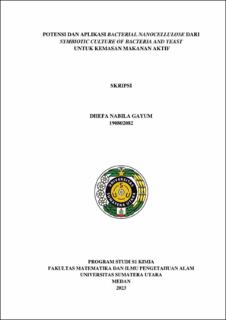| dc.description.abstract | Bacterial nanocellulose films produced using a green and inexpensive approach can serve as a basic material for replacement of plastic-based packaging. Active food packaging leads to extending the shelf life of food and maintaining higher quality. BNC does not have antimicrobial properties on its own, so combining BNC with chitosan can result in incorporation of antimicrobial properties to composite films. Making BNC-chitosan using the SIFB method. This research aims to create an active food packaging film that can replace the use of plastic. In this study, apples, eggplants, and chicken meat were used as subjects for the application of BNC. chitosan films. The results of FTIR and SEM analysis show that the process of combining BNC and chitosan was successful. The characteristics of BNC-chitosan can be used as active food packaging, namely by testing tensile strength and WVTR yielding good values of 16.7763 Mpa and 0.1928 kg s m³, so as to protect the product from mechanical strength and prevent moisture from entering. Antibacterial activity testing on Escherichia coli and Staphylococcus aureus bacteria on BNC- chitosan showed a strong inhibition zone, and antioxidant activity tests obtained an ICs value which was a strong category of 98.0187 ppm. So that the food packaging obtained can extend the storage time of apples, eggplants, and chicken meat. This can also be proven by the results of the shelf life tests on apples, eggplants, and chicken meat with active food packaging which got good results with storage times of 21 days. 6 days, and 24 hours. Compared with apples, eggplam, and chicken wrapped in plastic wrap and BNC, each of which rots faster. | en_US |





